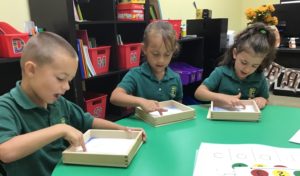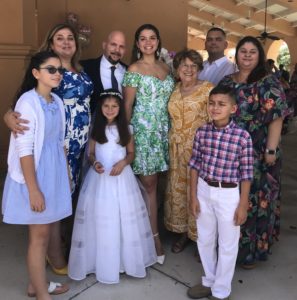
Mia spent the 2018-2019 school year meeting regularly with reading coach Amy McGuigan, a veteran classroom teacher who took Orton-Gillingham training with the Institute for Multi-Sensory Education in January 2018. McGuigan works with small groups of struggling readers in kindergarten through fourth grade classrooms.
The Orton-Gillingham teaching strategy breaks down reading and spelling into smaller skills involving letters and sounds, and then builds on those skills over time. Educators use sight, hearing, touch and movement to help students connect with concepts in fun and meaningful ways.
“Each year I’d see more and more kids who had gaps in their reading. Was it our curriculum? Was it our reading series? What did we need to fix?” McGuigan recalled.
“At the end of the first day [of IMSE training], I thought: I’m so sad that I didn’t get trained in this years ago when I first started teaching because everything just makes sense with this program — just the sequential, systematic, multi-sensory strategies that they teach you. … I remember texting my principal: Oh, my gosh. I found what we need.”
McGuigan hit the ground running with OG lessons — and said her students get most excited about multi-sensory activities like writing in sand and shaving cream.
Saint Juliana Catholic School is home to roughly 340 students in southeast coastal Florida. Most kids at the pre-K through eighth grade parochial school come from middle income backgrounds; scholarships are available. The school is racially diverse with a large Hispanic population. Class sizes typically sit at 20 to 25.
From September 2018 to March 2019, Mia’s Star Reading Assessment scaled score jumped 248 points from 542 to 790. Another student saw a 327 point jump from 76 to 403, while a third student jumped 151 points from 603 to 754, according to data provided by McGuigan.

Star Reading Assessment data for Mia Nunez
But it’s not just test scores that have the Saint Juliana community excited. It’s the jolt of self-confidence that comes with finally being able to read.
During her First Communion on May 11, Mia read a three-paragraph passage aloud at church — something she never would’ve attempted at the start of the school year.

Mia Nunez (third from left in white dress) with her family at First Communion. Mia is with her sisters (blue dress with white cardigan; green dress) and parents (suit; blue and white dress).
“I’m so proud of her,” Mia’s mother, Lori Nunez, said. “It brought back all this confidence. Her anxiety has diminished. … She felt horrible that she was the only one in her classroom who didn’t know how to read. She was very shy and very timid. And now, I’m telling you: She’s a different child. It changed her personality. It changed her confidence. It changed her completely as a child, as a person.”
Nunez recalled a powerful moment on a routine drive. While sitting in the backseat with her older sister, Mia picked up a pamphlet and began reading aloud. Nunez started to cry and immediately phoned multiple relatives so that they, too, could listen in.
“I had not heard her read by herself [at that point],” Nunez said. “She sat in the backseat, and I could hear her. She did not stumble through any words. She read right through. And I sat there and cried, and I called my mother up and put her on speakerphone.”
Orton-Gillingham lessons have been so successful at Saint Juliana that Kervi has budgeted to send two or three teachers to IMSE’s OG workshops each year until every K-2 teacher has been trained. The principal then hopes to send teachers in grades 3-5.

Reading coach Amy McGuigan works with students at Saint Juliana Catholic School in West Palm Beach, Florida.
“Not everybody learns the same way,” Kervi said. “It seemed like such a no-brainer to break things down in a more scientific way, if you will, for some of these kids where reading is not a natural process for them. … It’s a beautiful thing to be able to show them: You just learn differently. You just needed to be taught in a different way.”
Kervi touted the benefits of training an entire staff in the same “academic languages.”
“It helps us fill in those vertical gaps from year to year if we’re all on the same page,” she said. “We were all trained to use Thinking Maps. That’s something that we want the kids to use from the time they’re in pre-K or kindergarten, all the way up to eighth grade. It’s a great resource and a great tool. And we feel the same way about Orton-Gillingham — it’s not something that you learn in kindergarten and that’s it. It’s a way of instructing the students, and they need that instruction all the way through high school. It isn’t a one-stop shop. It isn’t a one-time thing. They’re going to need that support.”
“I think the word is definitely out about Orton-Gillingham, and I’m its No. 1 cheerleader,” McGuigan said. “The training I received with IMSE was phenomenal. I mean, sometimes you leave these trainings and you’re kind of confused: Gosh, where do we even start? And they make it so clear [at IMSE]. Okay, you’re going to start with this three-part drill. You’re going to introduce your new concept. You’re going to work on your dictation piece. You’re going to work on your phonemic awareness. You leave there with the knowledge to take it back to your classroom and hit the ground running, for sure.”
IMSE believes that all children should be able to read. To achieve this end, IMSE wants to bring Orton-Gillingham to all educators to give children the best literacy instruction possible.
Learn more about what you can do to improve literacy for all using the Institute for Multi-Sensory Education’s Orton-Gillingham training.
Please connect with us on Facebook, Twitter, and Pinterest to get tips and tricks from your peers and us. Read the IMSE Journal to hear success stories from other schools and districts, and be sure to read the OG Weekly email series for refreshers and tips.
